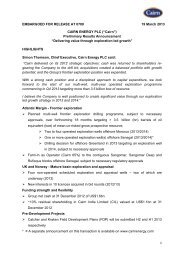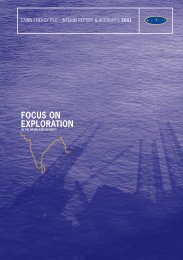Download Nautical Annual Report and ... - Cairn Energy PLC
Download Nautical Annual Report and ... - Cairn Energy PLC
Download Nautical Annual Report and ... - Cairn Energy PLC
You also want an ePaper? Increase the reach of your titles
YUMPU automatically turns print PDFs into web optimized ePapers that Google loves.
<strong>Nautical</strong> Petroleum plc <strong>Annual</strong> report <strong>and</strong> accounts 2010<br />
34<br />
Notes to the financial statements<br />
1. Authorisation of financial statements <strong>and</strong> statement of compliance with IFRS<br />
The Group’s financial statements of <strong>Nautical</strong> Petroleum plc for the year ended 30 June 2010 were authorised for issue by the Board of<br />
Directors on 8 October 2010 <strong>and</strong> the statement of financial position was signed on the Board’s behalf by Stephen Jenkins <strong>and</strong> William<br />
Mathers. <strong>Nautical</strong> Petroleum plc is a public limited company incorporated <strong>and</strong> domiciled in Engl<strong>and</strong> <strong>and</strong> Wales. The Company’s ordinary<br />
shares are traded on AIM on the London Stock Exchange.<br />
2. Accounting policies for the consolidated financial statements<br />
(2.1) Basis of preparation<br />
These consolidated financial statements have been prepared in accordance with the requirements of IFRSs (International Financial<br />
<strong>Report</strong>ing St<strong>and</strong>ards) as adopted by the European Union (EU) as they apply to the consolidated financial statements of the Group for the<br />
year ended 30 June 2010, <strong>and</strong> applied in accordance with the provisions of the Companies Act 2006. The Group’s financial statements are<br />
presented in sterling <strong>and</strong> all values rounded to the nearest thous<strong>and</strong> pounds (£000) except where otherwise indicated.<br />
The Board has reviewed the accounting policies set out below <strong>and</strong> considers them to be appropriate to the Group’s business activities.<br />
(2.2) Basis of consolidation<br />
These consolidated financial statements of the Group comprise the financial statements of <strong>Nautical</strong> Petroleum plc (“<strong>Nautical</strong>”) <strong>and</strong> its<br />
subsidiaries as at 30 June 2010, including the results of the subsidiaries, which are prepared for the same reporting year as the Parent<br />
Company using consistent accounting policies.<br />
All intercompany balances, transactions, income <strong>and</strong> expenses <strong>and</strong> profits <strong>and</strong> losses resulting from intra-group transactions are<br />
eliminated in full. Subsidiaries are fully consolidated from the date of acquisition, being the date on which the Group obtains control, <strong>and</strong><br />
continue to be consolidated until the date that such control ceases. Control is normally evident when <strong>Nautical</strong>, or a company which it<br />
controls, owns more than 50% of the voting rights of a company’s share capital.<br />
Minority interests represent the portion of profit or loss <strong>and</strong> net assets not held by the Group <strong>and</strong> are presented separately in the<br />
consolidated statement of comprehensive income <strong>and</strong> within equity in the consolidated statement of financial position, separately from<br />
parent shareholders’ equity.<br />
Where a minority interest is acquired, the difference between the cost of the additional interest in the subsidiary <strong>and</strong> the minority<br />
interest’s share of the assets <strong>and</strong> liabilities reflected in the consolidated statement of financial position at the date of the acquisition of<br />
the minority interest is reflected as being a transaction between owners <strong>and</strong> the difference is therefore taken to equity.<br />
(2.3) Significant accounting judgements <strong>and</strong> estimates<br />
In the process of applying the Group’s accounting policies, management make judgements <strong>and</strong> estimates. The key assumptions<br />
concerning the future, <strong>and</strong> other sources of estimation uncertainty at the balance sheet date, that have a significant risk of causing a<br />
material adjustment to the carrying amounts of assets <strong>and</strong> liabilities in the financial year are as follows:<br />
»» The Group makes judgements whether the exploration <strong>and</strong> evaluation assets are impaired in accordance with policy 2.6.<br />
»» The estimates determining the unwinding of the discount on long-term conditional payments, being the expected timings of field<br />
development approval <strong>and</strong> first oil on the Mariner field.<br />
»» The inputs into the binomial model used to estimate the fair value <strong>and</strong> charge to income of share options granted.<br />
(2.4) Revenue recognition<br />
Revenue is recognised to the extent that it is probable that the economic benefits will flow to the Group <strong>and</strong> the revenues can be<br />
reliably measured.<br />
(2.5) Foreign currency translation<br />
The consolidated financial statements are presented in UK sterling, which is the Company’s functional <strong>and</strong> presentation currency. Each<br />
entity in the Group determines its own functional currency <strong>and</strong> items included in the financial statements of each entity are measured<br />
using that functional currency. As at 30 June 2010 all entities within the Group had a UK sterling functional currency. Transactions in<br />
foreign currencies are initially recorded in the functional currency using the rate ruling at the date of the transaction. Monetary assets<br />
<strong>and</strong> liabilities denominated in foreign currencies are re-translated at the functional currency rate of exchange ruling at the balance sheet<br />
date. All differences are taken to the income statement.<br />
(2.6) Intangible assets – exploration <strong>and</strong> evaluation assets<br />
Capitalisation<br />
Certain costs (other than payments to acquire the legal right to explore) incurred prior to acquiring the rights to explore are charged<br />
directly to the income statement. All costs incurred after the rights to explore an area have been obtained, such as geological <strong>and</strong><br />
geophysical costs <strong>and</strong> other direct costs of exploration (drilling, trenching, sampling <strong>and</strong> technical feasibility <strong>and</strong> commercial viability<br />
activities) <strong>and</strong> appraisal are accumulated <strong>and</strong> capitalised as intangible exploration <strong>and</strong> evaluation (“E&E”) assets.<br />
E&E costs are not amortised prior to the conclusion of appraisal activities. At completion of appraisal activities, if technical feasibility is<br />
demonstrated <strong>and</strong> commercial reserves are discovered, then, following development sanction, the carrying value of the relevant E&E<br />
asset will be reclassified as a development <strong>and</strong> production asset, but only after the carrying value of the relevant E&E asset has been<br />
assessed for impairment, <strong>and</strong> where appropriate, its carrying value adjusted. If, after completion of appraisal activities in an area, it is not<br />
possible to determine technical feasibility <strong>and</strong> commercial viability or if the legal right to explore expires or if the Company decides not<br />
to continue exploration <strong>and</strong> evaluation activity, then the costs of such unsuccessful exploration <strong>and</strong> evaluation is written off to the<br />
income statement in the period the relevant events occur.
















